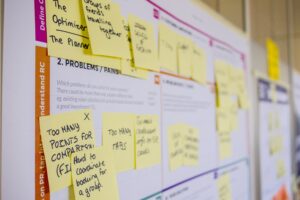In today’s competitive business environment, it’s more crucial than ever for companies to understand their customers’ needs, preferences, and behaviors. One effective way of gaining insights into customers is by conducting interviews. However, simply conducting interviews is not enough. To get the maximum value from customer interviews, businesses must know how to interpret and apply the insights they gather.
Introduction: The Importance of Customer Interviews in Business Development
Customer interviews are a critical component of any successful business development strategy. These interviews offer a unique opportunity for businesses to connect with their customers on a personal level and gain valuable insights into their needs, preferences, and pain points. By conducting customer interviews, businesses can develop a deeper understanding of their target audience and use this knowledge to improve their products or services.
One of the primary benefits of customer interviews is that they provide direct feedback from customers. This feedback can be used to identify areas where a business is excelling and areas where improvement is needed. By listening to their customers, businesses can gain a competitive edge by offering products and services that meet their needs more effectively than their competitors.
Another benefit of customer interviews is that they can help businesses to identify emerging trends in their industry. By asking customers about their future needs and preferences, businesses can stay ahead of the curve and position themselves as industry leaders.
In addition to these benefits, customer interviews can also help businesses to build stronger relationships with their customers. By showing that they are genuinely interested in their customers’ opinions and feedback, businesses can foster a sense of loyalty and trust that can be difficult to achieve through other means.
Overall, customer interviews are an essential tool for businesses that are looking to improve their products or services and stay ahead of the competition. By taking the time to connect with their customers and listen to their feedback, businesses can gain valuable insights that can be used to drive growth and success in the long term.
Active listening is a skill that can be honed with practice. One way to practice active listening is to repeat back what the customer has said in your own words. This not only shows the customer that you are listening, but it also helps ensure that you have understood their message correctly. Asking clarifying questions can also help to avoid misunderstandings and ensure that you are on the same page as the customer.
It’s important to note that active listening is not just about hearing the words that the customer is saying. It also involves paying attention to nonverbal cues such as body language and tone of voice. These cues can provide valuable insights into the customer’s emotions and attitudes towards the product or service being discussed.
Active listening can also help to build rapport with the customer. By showing that you are genuinely interested in their thoughts and opinions, you can establish a relationship based on trust and mutual respect. This can lead to more honest and open communication, which in turn can provide even deeper insights into the customer’s needs and desires.
Finally, active listening is just the first step towards gaining valuable insights from customer interviews. Once you have listened carefully to what the customer has to say, it’s important to analyze the information and use it to inform your business decisions. This may involve identifying patterns or trends in the customer feedback, or using the insights gained to develop new products or services that better meet the needs of your target audience.
Overall, active listening is a crucial skill for businesses looking to gain a deeper understanding of their customers. By remaining objective, paying attention to nonverbal cues, and building rapport with the customer, businesses can gain insights that may not be immediately apparent. And by using these insights to inform their decisions, businesses can stay ahead of the competition and better meet the needs of their customers.
Identifying Patterns and Themes
Once the customer interview is over, the data collected must be analyzed to identify patterns and themes. This analysis helps to identify the recurring issues or topics that customers are concerned about, allowing businesses to address them more effectively.
However, analyzing customer feedback can be a daunting task, especially if the business receives a large volume of responses. To make the process more manageable, businesses can use tools such as text analysis software to automatically identify common themes and sentiment in the data.
Once the themes have been identified, it’s important to prioritize them based on their impact on the customer experience and the business. Some themes may be more urgent than others and require immediate attention, while others may be less pressing but still important to address in the long term.
It’s also important to look for patterns within the themes. For example, if many customers are complaining about long wait times, are they all experiencing the same issue, or are there different factors contributing to the problem? By identifying patterns within the themes, businesses can develop more targeted solutions that address the root cause of the problem.
Another useful technique for analyzing customer feedback is to categorize the feedback into different types, such as positive, negative, or neutral. This can help businesses to understand the overall sentiment of their customers and identify areas where they are doing well and areas where they need to improve.
Overall, analyzing customer feedback is a crucial step in improving the customer experience. By identifying patterns and themes, businesses can develop targeted solutions that address the most pressing issues and improve customer satisfaction.
Assessing Customer Needs and Pain Points
One of the primary goals of customer interviews is to understand their needs and pain points. By listening to their feedback, businesses can identify what their customers want, how they want it, and what’s causing them difficulties.
For example, a business may learn that customers want a more intuitive web interface for placing orders. Armed with this information, the business could allocate resources to overhaul their website or create a new application that addresses these concerns.
Understanding Customer Behaviors and Motivations
Customer interviews also provide insight into customer behaviors, which can help businesses forecast trends and predict future needs. By understanding why customers make certain choices, businesses can develop more effective marketing strategies, product designs, and sales approaches.
For example, a company may discover that customers are increasingly looking for environmentally sustainable products. This insight can lead the business to redesign their processes, source materials from more sustainable sources, and market their commitment to sustainability to attract more customers.
Translating Feedback into Actionable Steps
Customer interviews are ultimately about transforming feedback into action. This means developing an actionable plan based on the insights gleaned from the interview. For instance, a business could create a roadmap of the changes they intend to make, prioritizing the most critical pain points and gradually implementing changes over time.
It’s essential to ensure that the changes made are targeted at solving specific problems, rather than making things look good on paper. The goal should be to deliver the most significant impact possible with the resources available and minimizing any unintended side effects.
Prioritizing Changes Based on Customer Input
Not all insights are created equal, and some customer feedback may have a more significant impact than others. Therefore, it’s essential to separate the signal from the noise and prioritize changes based on the most critical insights gleaned from the interview.
For example, a business may discover that their customers are having trouble with their returns policy. This customer feedback is likely to have a more significant impact on the business than a request for additional payment methods, which can be addressed later.
Conclusion: Turning Customer Insights into Competitive Advantage
Customer interviews are an integral part of developing products and services that meet the needs of the market. By understanding their customers’ needs, preferences, and behaviors, businesses can make strategic decisions that differentiate them from the competition and provide them with a competitive advantage.
With a foundation of active listening and objective interpretation of data, businesses can develop actionable steps that prioritize the insights gleaned from customer interviews. The result is a better understanding of their audience and a stronger position in the marketplace.








